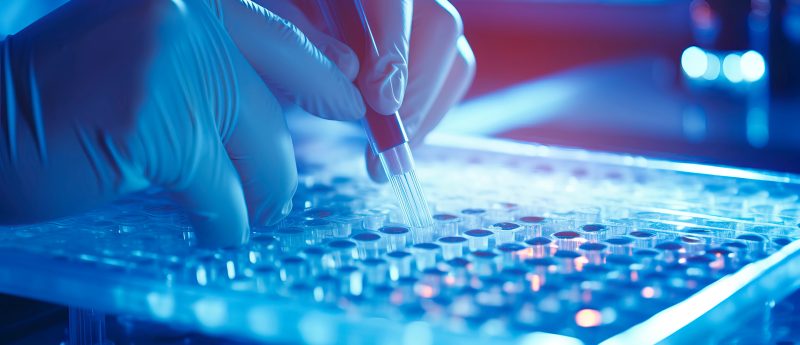Webinar Q&A follow up: ‘A hybrid LBA/LC-MS assay: realize the best of both worlds’

Thank you everyone who attended the live webinar: A hybrid LBA/LC-MS assay: realize the best of both worlds. Below are responses to the questions posed during the live event that we did not have time to answer. We hope this is a useful resource and thank our webinar attendees and our speakers, Suma Ramagiri, PhD (SCIEX) and Lei Xiong, PhD (SCIEX), for their time.
Q&A follow-up
1. You mentioned immunocapture based sample preparation is more automation friendly. Could you explain how we can transfer the method to a robotic system?
Transferring an immunocapture procedure to a robotic system can be very straightforward and done by simply programming every step in the robotic system. We have programmed the entire immunocapture based sample preparation procedure in the Beckman Biomek Fx workstation. By simply clicking one bottom on the software interface, Biomek Fx will perform the sample preparation.
2. What is the insulin sample recovery efficiency of immunocapture sample preparation like when compared to a SPE workflow?
Insulin sample recovery of immunocapture depends on the antibody capture efficiency. Capture efficiency is affected by peptide sequences and structures. In our method, we use anti-insulin antibody as the capture antibody. We observe very high (>80%) recovery efficiency for native intact insulin, and slightly lower recovery efficiency for insulin analogues with different peptide sequences from the native insulin. Nevertheless, immunocapture sample recovery is higher than SPE recovery for native insulin and insulin analogues.
3. How easy is it to automate the BioBA kit on the Biomek workstation?
See response to Q.1.
4. Is this use of magnetic beads a rugged method?
Magnetic beads based sample preparation has become a very popular method for biosample analysis. The major advantages of using magnetic beads include: the variety of antibody types that can be coated on the beads surface using streptavidin biotin conjugation, the flexibility of beads usage amount, the ease of automation and assay robustness.
5. How do you measure anti-drug antibodies (ADA) using LC-MS knowing that the ADA is most of the time an unknown protein? i.e. no possibility to use a standard or a peptide.
ADA are IgM, IgE and other IgG isotypes. The sequence information for these antibodies is known. In an MRM based peptide quantitation workflow; we have to know the protein/peptide sequences in order to create the MRM method. When the protein/peptide sequence is unknown, a protein identification experiment and protein database search need to be processed first. Then a MRM based or SWATH based method can be created for peptide quantitation. A stable isotope labeled IgG can be used for quantitation of ADAs in plasma or serum.
6. How is peak asymmetry calculated with MultiQuant Software?
In MultiQuant software, the parameter ‘Asymmetry Factor’ in the result table represents the peak asymmetry evaluation result. Asymmetry Factor is the distance from the center line of the peak to the back slope, divided by the distance from the center line of the peak to the front slope, with all measurements made at 10% of the maximum peak height. The closer this value is to 1, the more symmetric the peak shape is.
7. Can you comment on non-specific binding issues you may have observed, especially when dealing with both small and large molecules? We’ve often found the low-binding plastics work great for large molecules, but terrible for small.
Non-specific binding is the common issue observed for proteins, large peptide and other hydrophobic compounds. A few factors will affect non-specific binding, including sample storage (sample vial material, surface pretreatment), solvent components (organic percentage, pH, and modifier), matrix (complex matrix can eliminate non-specific binding) and sample preparation details (SPE: bedding size, pore size, pretreatment, wash buffer, elution condition; immunocapture: antibody-beads ratio, wash buffer). There are a few strategies to avoid non-specific binding by adding 0.1% BSA in the sample, saturating the reactive sites on LC, auto sampler and column by repeated injection of 0.1% BSA samples before the sample analysis.
8. What sample volume do you use for insulin analysis?
We usually use 200-250 uL human plasma per sample.
9. How long were your assay run times from beginning to end?
We developed the sample preparation protocol to fit in 9-5 working hours in a day. Assay run time depends on the incubation time and the number of samples to prepare. For 96 samples, it takes about 6-6.5 hrs, including 3hrs for immunocapture (sample preparation, beads preparation, beads incubation and more) and 3-3.5 hrs for protein digestion (protein denaturation, reduction, alkylation and digestion).
10. What volume of plasma are you working with to achieve a 5 ng/mL LLOQ?
It can be analyte dependent. For our mAb quantitation assay, we use 50 uL to 200 uL plasma to achieve 5 ng/mL LLOQ.






